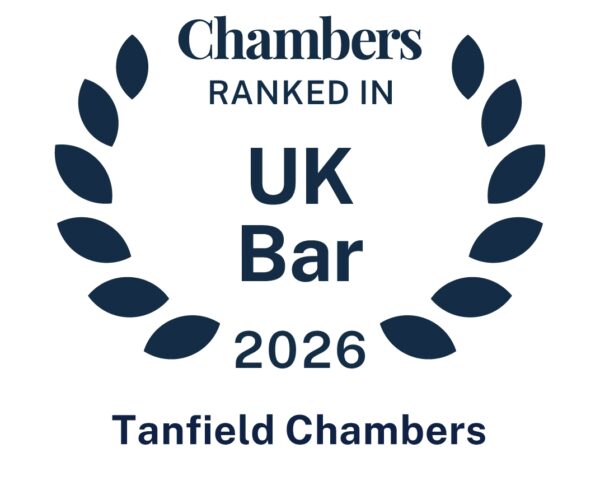Edward Denehan and Julian Torres-H-B have presented a detailed and insightful webinar
Banks Beware! Waller-Edwards v One Savings Bank Plc [2025] UKSC 22
![Banks Beware! Waller-Edwards v One Savings Bank Plc [2025] UKSC 22](https://tanfieldchambers.co.uk/wp-content/uploads/2024/12/shutterstock_2343368699-2-1800x1200-jpg.webp)
Sam Madge-Wyld and Sami Allan consider the Supreme Courts recent decision in Waller-Edwards v One Savings Bank plc, an important case for lenders dealing with non-commercial transactions
Background to the appeal
On 4 June 2025, the Supreme Court handed down its decision in Waller-Edwards v One Savings Bank Plc. Lady Simler, with whom the other 4 Justices hearing the appeal agreed, began her Judgment at [1] by observing that:
The law recognises that there are certain (non-commercial) relationships where there is a heightened risk that one party has an undue influence over the other: the husband-and-wife relationship is an obvious example but there are others too.
The law of equity has recognised this to be the case for some time. Back in 2001, Lord Nicholls – in Royal Bank of Scotland Plc v Etridge (No.2) [2001] UKHL 44 – said that this is “well known to every law student”.
In Etridge, the House of Lords decided that whenever a spouse (husband, wife or civil partner) stands as surety for their partner’s debts (i.e. they receive no benefit from the transaction) a bank is put on inquiry that there is a risk of undue influence. In such cases, if it is found that the transaction was a result of undue influence the loan is set aside unless the bank has taken steps (prescribed in Etridge) to ensure that the at-risk party is aware of the nature of the transaction. On the other hand, a bank is not put on inquiry where a loan is made to the spouses jointly unless the bank has actual notice that the real purpose of the loan is for only for one party’s benefit.
As to what steps the bank must take when put on inquiry (“the Etridge Protocol”), these were authoritatively summarised by Lady Simler at [33]:
(a) The bank must communicate directly with the wife, informing her that for her own protection it will require written confirmation from a solicitor, acting for her, to the effect that the solicitor has fully explained to her the nature of the transaction and its practical implications for her; and that the purpose of this requirement is that she will not be able to dispute that she is legally bound by the transaction once the surety documents are signed.
(b) The bank must ask the wife to nominate a solicitor she is willing to instruct to advise her, separately from her husband, and act for her in giving the necessary confirmation to the bank; that solicitor may be the same solicitor who is acting for the husband but if a solicitor is already acting, she should be asked whether she would prefer a different solicitor.
However, the question in Waller-Edwards was different: in what circumstances is a bank put on inquiry (and therefore required to follow the Etridge protocol), where, on the face of it, a transaction is for the joint benefit of both the husband and wife and for one of the parties sole-benefit, e.g. it is used to fund a joint venture business and to clear one person’s debts?
The facts
In 2011, the Appellant entered into a relationship with Mr Bishop. At the time, the Appellant was financially independent, but emotionally vulnerable. Mr Bishop, a builder, was constructing a property known as Spectrum when the parties’ relationship commenced. Spectrum was encumbered by (i) a charge securing a debt to Mr Higgins, and (ii) a charge to secure an investment made by the Appellant in the property. The couple then moved into Spectrum before the works were completed, with legal title to the property being held in their joint names, but a declaration of trust provided that the Appellant owned 99% of it.
In 2013, Mr Bishop re-mortgaged Spectrum under a buy-to-let mortgage. The bank advanced £384,000. The bank was told that (i) £233,000 of the loan was to be used to discharge the existing mortgages, (ii) £100,000 would be used to buy a home for the couple, and (iii) £39,500 would be used to pay off debts owed by Mr Bishop. In fact, £142,000 was used to make a divorce payment to Mr Bishop’s ex-wife.
In mid-2014, the Appellant and Mr Bishop separated after their relationship came to an end. The Appellant continued to live in Spectrum. After she ceased paying the mortgage, the Bank brought a claim for possession of Spectrum.
The Appellant defended the claim on the basis that the mortgage should be set aside for undue influence. She argued that the Bank was put on inquiry as a result of their knowledge that Mr Bishop intended to use £39,500 of the loan to pay off his debts. At trial, it was determined that the transaction was procured by undue influence. However, the court declined to set aside the mortgage because the loan was not solely for her husband’s benefit. On the trial judge’s analysis, one had to look at the transaction as a whole and decide whether it was being made for the purpose of one party’s debts, as distinct from the joint purpose. The lower court therefore found this was not a transaction that put the bank on inquiry as, from a global perspective, it was a loan made for the joint benefit of both the Appellant and Mr Bishop.
An appeal to the Court of Appeal was unsuccessful and the Appellant appealed to the Supreme Court.
The Supreme Court reasoning
Lady Simler (with whom the other members of the court agreed) allowed the appeal. She held that the question of whether a bank was put on inquiry was a binary question: did the nature of the transaction create a heightened risk that one party had an undue influence over the other? She held that a non-commercial transaction in which one party agreed to stand as surety or discharge another person’s debt created such a risk irrespective of whether the remaining sums advanced were to be used for the parties’ joint benefit. It is only where the sums advanced for the benefit of one party were “de-minimis” that a bank would not be put on inquiry.
The effect of this was to create a bright-line test, which did not permit the court to undertake a fact and degree assessment in each case. This is consistent with the underlying principle in Etridge, where Lord Hobhouse explained at [108] that “the advantage of this low threshold is that it assists bank to put in place procedures which do not require an exercise of judgment by their officials”.
In this case, the discharging of Mr Bishop’s debts totalling £39,500 was not de-minimis. This meant that the bank had been put on inquiry and its failure to follow the Etridge protocol meant that the mortgage had to be set aside.
This content is provided free of charge for information purposes only. It does not constitute legal advice and should not be relied on as such. No responsibility for the accuracy and/or correctness of the information and commentary set out in the article, or for any consequences of relying on it, is assumed or accepted by any member of Tanfield or by Tanfield as a whole.







